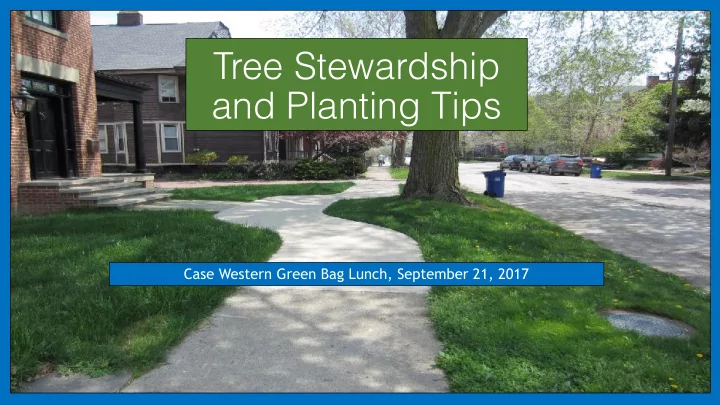

Tree Stewardship and Planting Tips Case Western Green Bag Lunch, September 21, 2017
The Cleveland Tree Plan Summary
The Cleveland Tree Plan Why Trees? Over 100 years trees appreciate Other infrastructure depreciates
The Cleveland Tree Plan Why Trees? In Cleveland that means $28 million in annual benefits ❖ 1.8 billion gallons of rainwater every year (value: $11 million). ❖ Saves residents and business owners $3.5 million in energy costs each year.
The Cleveland Tree Plan Why Trees? In Cleveland that means $28 million in annual benefits ❖ 1.8 billion gallons of rainwater every year (value: $11 million). ❖ Saves residents and business owners $3.5 million in energy costs each year.
The Cleveland Tree Plan The Way Forward: Action Steps ❖ Action #8: Institute policy changes supportive of urban forestry
The Cleveland Tree Plan The Way Forward: Action Steps ❖ Action #9: Plant with a purpose: trees for neighborhood equity
The Cleveland Tree Plan ❖ Select Qualified Arborists How Can You Make a Difference?
Tree Steward Training
Tree Steward Program Curriculum focused on: • Urban Forestry • Tree Biology • Tree Identification • Tree Stress • Root and Soil Management • Planting, Pruning and Care • Community Forestry
Tree Steward Program Process (four parts) Classroom Parts I&II (curriculum) Outdoor Parts III&IV (planting/care)
Tree Steward Program Learning Objectives 1. Increased awareness of trees and the benefits they provided 2. Basic ability to plant and care for trees in the community 3. Willingness to organize and participate in community forestry events
Regional Initiatives and Partnerships Cleveland Tree Plan Cleveland Tree Coalition Public/Private Grants and Partnerships
Planting • Inspect your trees before planting! • Tree planting is short Tree lives are long • • Do it right the first time – tag your trees!
Plant Selection • Match the tree to the site • Select healthy/quality trees • Inspect the root ball
Plant Selection • Inspect branches, trunk, and roots • Look for circling roots • These can lead to girdling roots
Plant Selection • Inspect branches, trunk, and roots • Look for circling roots • These can lead to girdling roots
Plant Selection • Inspect branches, trunk, and roots • Look for circling roots • These can lead to girdling roots
Plant Selection • Inspect structure (central leader) • Look for pests/diseases • No injuries to trunk or root collar
Stock Type • Bare root • Pro: small/light/ see all roots • Con: dry out easily/dormant planting season
Stock Type • Containerized/container grown • Pro: easy to move/ relatively light • Con: Substrate grown/ circling or girdling roots
Stock Type • Containerized/container grown • Often have excessive or defective roots • Substrate grown
Stock Type • Balled and Burlapped (B&B) • Pro: soil-based root ball • Con: heavy/lose 90% of roots/deep roots/ hidden issues
Stock Type • Balled and Burlapped (B&B) Wire basket • Pro: soil-based root ball • Con: heavy/lose 90% of roots/deep roots/hidden issues
Stock Type • Balled and Burlapped (B&B) • Pro: soil-based root ball Deep roots • • Con: heavy/lose 90% of roots/deep roots/hidden issues
Stock Type • Balled and Burlapped (B&B) • Pro: soil-based root ball Deep roots • • Con: heavy/lose 90% of roots/deep roots/hidden issues
Planting Techniques Locate utilities • Above and below ground • Practice ‘Right Tree Right Place’ •
Planting Techniques • Shallow/Wide planting hole
Planting Techniques • Too deep!
Planting Techniques • Too deep!
Planting Techniques • Root flare near grade
Planting Techniques • Root flare near grade
Planting Techniques • Do not over-dig!
Planting Techniques • Remove planting materials
Planting Techniques • Correct root defects
Planting Techniques • Correct root defects
Planting Techniques • Check drainage/no gravel ( perched water table)
Planting Techniques • Fill in with site soil • 2-3x root ball
Planting Techniques • Top-dress with compost/woodchips
Planting Techniques • Top-dress with compost/woodchips
Transplanting • Root pruning • Trees can be hardened off to help acclimation • Drum lace large root balls Photos courtesy GardenWeb and Tree PGH
Transplanting • Root pruning • Trees can be hardened off to help acclimation • Drum lace large root balls Photos courtesy GardenWeb and Tree PGH
Transplanting • Tree spade used for digging • Take care when transporting • Protect your investment
Transplanting • Tree spade used for digging • Take care after planting
Early Care • Planting is just the start! • Transplant shock can cause increased mortality • Just add water! Be sure to repeat
Early Care • Fertilization • Mulching • Staking or Guying
Early Care • Fertilization • Mulching • Staking or Guying
Early Care • Fertilization • Mulching • Staking or Guying
Early Care • Tree wrap • Root collar guards Photos of wraps/guards courtesy A.M. Leonard
Early Care • Tree wrap • Root collar guards Photos of wraps/guards courtesy A.M. Leonard
Early Care • Pruning • Yes, just a small amount at planting • Include dead or broken branches too Photos courtesy Dr. Ed Gilman
Early Care • Pruning • Yes, just a small amount at planting • Include dead or broken branches too
Early Care • Use ANSI A300 for planning specifications • Tree planting best management practices too! • Include detailed drawings too
Early Care • Use ANSI A300 for planning specifications • Tree planting best management practices too! • Include detailed drawings too
Tree Planting & Establishment January 31, 2017 The Ohio Tree Care Conference
Tree Planting & Establishment January 31, 2017 The Ohio Tree Care Conference
Tree Planting & Establishment January 31, 2017 The Ohio Tree Care Conference
Tree Planting & Establishment January 31, 2017 The Ohio Tree Care Conference
Tree Planting & Establishment January 31, 2017 The Ohio Tree Care Conference
Tree Planting & Establishment January 31, 2017 The Ohio Tree Care Conference
Happy Planting! Diana Sette Arborist Educator The Holden Arboretum 9500 Sperry Road Kirtland, Ohio 44094 p: 267-423-0340 f: 440.256.5836 http://www.holdenarb.org/resources/communityforestry.asp
Recommend
More recommend